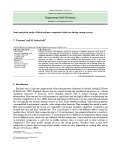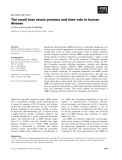
The induced residual stress
-
In this paper residual stress in thick layer composites have been studied. Using numerical analysis, the curing process has been modeled and mechanical properties of a thick layer composite are obtained and the induced residual stress in these composites has been assessed. Unlike thin layer composites, the stress in each layer is not specific and a tensile and compressive stress field can exist simultaneously in thick layer composites.
 12p
12p  tocectocec
tocectocec
 25-05-2020
25-05-2020
 10
10
 0
0
 Download
Download
-
Small heat shock proteins (sHSPs) function as molecular chaperones, pre-venting stress induced aggregation of partially denatured proteins and pro-moting their return to native conformations when favorable conditions pertain. Sequence similarity between sHSPs resides predominately in an internal stretch of residues termed the a-crystallin domain, a region usually flanked by two extensions.
 15p
15p  awards
awards
 06-04-2013
06-04-2013
 37
37
 3
3
 Download
Download
-
Human cells contain two homologs of the yeast RAD23 protein, hHR23A and hHR23B, which participate in the DNA repair process. hHR23B hou-ses a domain (residues 277–332, called XPCB) that binds specifically and directly to the xeroderma pigmentosum group C protein (XPC) to initiate nucleotide excision repair (NER). This domain shares sequence homology with a heat shock chaperonin-binding motif that is also found in the stress-inducible yeast phosphoprotein STI1.
 10p
10p  awards
awards
 06-04-2013
06-04-2013
 33
33
 3
3
 Download
Download
CHỦ ĐỀ BẠN MUỐN TÌM















